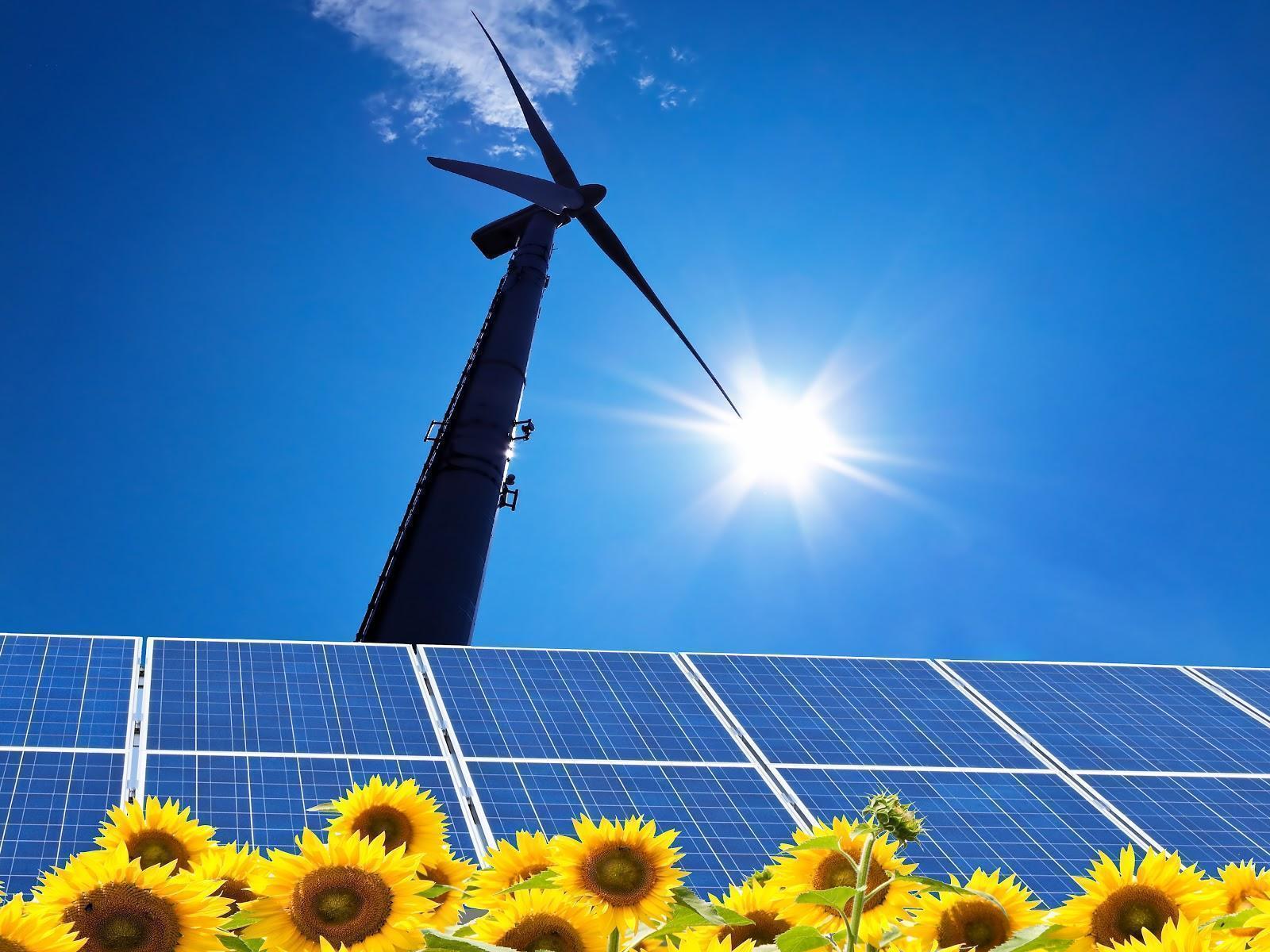
(Article First Published on: siliconindia.com | February 04, 2015)
Finland: Renewable energy brings a cheaper yet more efficient way to supply the energy needs not only in Asia but across the globe! Start saving energy today, visit our site to find better options: www.eco.ph
Finnish scientists believe that renewable energy sources, such as solar and wind power, will become the cheapest energy for consumers in Asia in next 10 years.
A joint project conducted by Finnish Technical Research Center (VTT) at the Lappeenranta University of Technology and the University of Turku has successfully modelled comprehensive energy systems based entirely on renewable energy sources for China, South Korea and Japan, Xinhua reported.
The project has recently won an award in Japan for its pioneering simulation work.
China, a leading energy consumer in the world, has become the world's largest investor in solar and wind energy, said VTT's Pasi Vainikka.
"China possesses significant wind and solar energy resources, so a power network based on renewable energy sources has the potential to become profitable very quickly," Vainikka was quoted as saying.
The researchers who participated in the project predicted that the price of solar electricity will drop by half within 10 to 15 years, so that the relative industries will become more profitable.
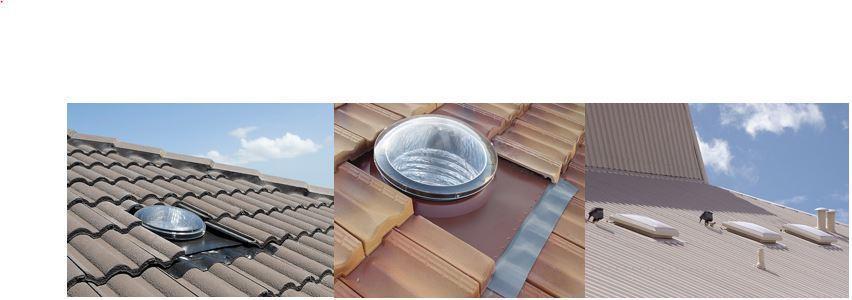
Skylights are considered to be one of the most reliable energy-saving devices utilizing the renewable energy of the sun in order to provide natural lighting inside an office or home.
With proper installation and positioning, this lighting device can allow up to five times more light than a regular window thereby improving the occupants’ utility of the interior space in a comfort in a highly cost-effective way.
Skylights can also enhance the curb value and aesthetic appeal of your property as well as contribute to reducing the Carbon Footprint that produces.
So if you want to enjoy the benefits it offers, here are some fundamental questions that you need to consider before installing skylights.
Are Skylights Applicable to any Size of House?
Skylights can be installed in any room of a house (single or multi-storey) as long as there is suitable access and sufficient ventilation as condensation can occur as it conveys light energy into the building.
What is Your Roof Framing at Home?
Before installing skylights, you should determine the kind of roof frame you have in your house. Basically, skylights can be installed on these two commonly used roof framing system- conventional and truss roof frame.
Larger size skylights can be installed on a conventional roof frame while truss roof frames usually require smaller skylights which can accommodate a maximum truss center of 2 feet.
Where is the Best Place for Your Skylights?
The best place to position your skylights should always be clear of any obstructions such as electrical wires, water heater pipes, heat and A/C ducts or anything that might serve as structural obstacle.
If you have a limited roof space, you can re-route the pipes or cable wires to clear out the space that you need in order to install them.
Does the interior colour scheme of your space affect the performance of Skylights?
Yes it does. Lighter, brighter colors will tend to reflect daylight around the room while dark colors will tend to absorb it. The best solution for this is to adjust the size or quantity of skylights to provide sufficient lighting inside your house.
Let the Experts Help You!
Do you need help in finding the most suitable skylights for your home? We provide Sky Tunnel Tubular Skylight that is designed to convey light with greater efficiency, security and ease than a conventional skylight design. If you want to get the job most efficiently, we can also install your Skylighting system for you and no job is too big or too small.
Contact us today at and we will be glad to answer your enquiries! Call us at (+6345) 499 1037 or fill in our contact form

(Article First Published on: news.asiaone.com | January 18, 2015)
China’s investment in renewable energy hit a record high of US$89.5 billion in 2014. This clearly shows the country’s vigorous efforts to cut down their energy expenses through its natural sources. Join the drive toward a clean energy, see how our products can contribute: www.eco.ph
China ranks the top in the world in terms of the use of renewable energy with the increasing switch to renewable energy resources, said senior official on Saturday.
China's investment in clean energy in 2014 hit a record US$89.5 billion (S$118.7 billion), accounting for 29 per cent of the world's total.
China's renewable energy generation capacity reached 430 million kilowatts by the end of 2014, accounting for 32 per cent of the country's total power capacity, said Shi Lishan, deputy director general of the New and Renewable Energy Department of the National Energy Administration during the fifth session of the International Renewable Energy Agency Assembly held in Abu Dhabi.
According to Shi, China's renewable power generation was 1.2 trillion kilowatt-hours in 2014, accounting for 22 per cent of the country's total power consumption in the last year.
China became a member of IRENA in January 2013, a milestone in international efforts to double the share of renewable energy worldwide by 2030.
Shi said China will strengthen communication on projects and technology in renewable energy industries with other member countries and regions.
"China will also make efforts to support underdeveloped countries' renewable energy development," Shi said.
Adnan Amin, director-general of IRENA, said China's renewable power generation costs including that of solar and wind energy have significantly reduced, which will help the country to improve its energy structure in the long run."

(Article first Published on: news.stv.tv/Scotland | January 03, 2015)
December was a record month for wind power in Scotland, according to environmentalists who have hailed 2014 as a "massive year" for renewable energy.
Renewable energy is taking off around the world, see how you can benefit today from SG Eco's range of products which promote natural lighting and ventilation, visit our site at www.eco.ph
The biggest day for output for wind was on December 10 when there was enough energy generated to supply 6.34 million homes for the whole day, analysis from WWF Scotland showed. The charity said wind turbines generated enough power to supply over 100% of Scottish households on 25 out of the 31 days of December.
Throughout the year wind provided enough power for the electrical needs of 98% of Scottish households, with solar power meeting two-thirds or more of household electricity or hot water needs, it added.
Lang Banks, WWF Scotland's director, said: "Without doubt, 2014 was a massive year for renewables, with wind turbines and solar panels helping to ensure millions of tonnes of climate-wreaking carbon emissions were avoided.
"With 2015 being a critical year for addressing climate change internationally, it's vital that Scotland continues to press ahead with plans to harness even greater amounts of clean energy.
"December turned out to be a record-breaking month for wind power, with enough green energy generated to supply a record 164% of Scottish households with the electricity they need.
"Even on calmer days, wind still supplied the equivalent of over a third of electricity needs of every home."
Using data provided by WeatherEnergy, the charity said for homes fitted with solar photo-voltaic systems, there was enough sunshine in Aberdeen, Edinburgh, Glasgow or Inverness to generate an estimated 100% or more of the electricity needs of an average property during June and July and 60% or more in the same four cities during March, April, May, August and September.
Karen Robinson, of WeatherEnergy, added: "We're famous in the UK for our obsession with the weather, but how often do we see it in a positive light? At a time when the world is desperately looking for low-carbon sources of energy, the data show that clean renewables are already playing a significant and growing role in Scotland's, and the rest of the UK's, overall energy mix. We just need to blow their trumpet a bit more.
"Scotland is clearly leading the way when it comes to wind power. However, despite misconceptions, Scotland also has potential for sun-loving renewables too. The data clearly show that there's plenty of sunshine to meet a significant proportion of an average family's electricity needs for most months of the year - even during some of the winter months. With hundreds of thousands of roofs, it would make sense to tap more of the sun's power."
SNP MSP Rob Gibson welcomed the findings and said: "Last year really was a massive year for renewable energy; these are very welcome figures which demonstrate that the Scottish Government's commitment to and investment in renewables are paying dividends.
"It is clearer than ever that Scotland's renewable electricity generation will play a key part in keeping the lights on across the UK - and to keeping energy bills down.
"With Scottish Government support our renewables industry is going from strength to strength - bringing jobs and investment to Scotland, reducing carbon emissions and performing a key role in meeting our energy needs. But there is always more that can be done."
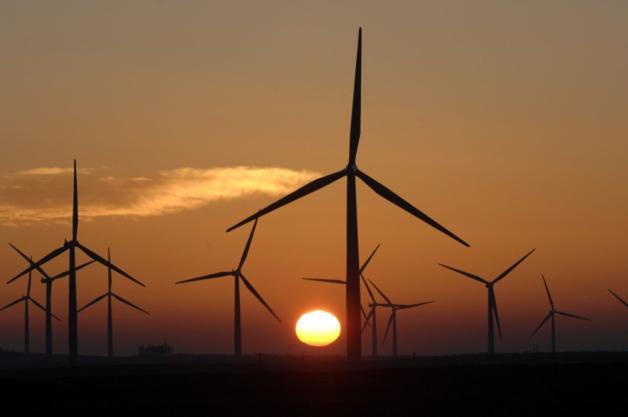
Renewable energy is taking off around the world, see how you can benefit today from SG Eco’s range of solar and wind driven lighting and ventilation solutions, visit our site at www.eco.ph
(Article first Published on: scotsman.com | November 27, 2014)
Climate campaigners yesterday welcomed the figures, saying they mark a “crucial tipping point” and signal the “beginning of the end” for fossil fuels and nuclear power.
The latest energy trends report from the Department of Energy & Climate Change (DECC) shows renewables generated 32 per cent more electricity than any other single source of power in Scotland in the first half of this year.
The sector – including solar, wind, hydro and biomass energy sources – produced a record 10.3 terawatt-hours of power. This compares to 7.8TWh from nuclear, 5.6TWh from coal and 1.4TWh from gas-fired power stations in the same period. Nuclear was previously the nation’s primary source of electricity.
Dr Richard Dixon, director of Friends of the Earth Scotland, said: “We have joined the pioneer nations who are leading the way to a 100 per cent renewables, zero-carbon world. Becoming the largest single source of electricity in Scotland is a tremendous milestone on the way to meeting all of our electricity demand from green energy sources in just six years’ time.”
WWF Scotland director Lang Banks said: “Last month, while nuclear reactors were forced to shut because of cracks, Scotland’s renewables were quietly and cleanly helping keep the lights on in homes across the country.
“Wind turbines in Scotland alone generated enough electricity to supply three million homes in the UK – equivalent to 126 per cent of the electricity needs of every home north of the Border.”
However, last night Linda Holt, spokesperson for Scotland Against Spin, said: “Wind energy is intermittent and uncontrollable, and cannot be relied upon to provide either baseload or despatchable generation. Without large-scale storage capacity – which does not exist – wind can never be the mainstay of any country’s domestic electricity consumption. The more wind is added to the energy mix, the more expensive electricity becomes because of the need for back-up, balancing and grid expansion. As those 6.3TWh of wind-generated electricity cost millions in subsidies, they are directly responsible for plunging Scots into fuel poverty.”
Scottish Labour leadership contender Neil Findlay, MSP for Lothian and a long-standing critic of government renewable energy policies, said: “I am not against renewable energy but before we rush to applaud this report we need to face up to two major criticisms.
“Firstly, what we have is a lack of co-ordinated approach, with communities inundated by speculative applications from developers. Secondly, it is the corporations and venture capital firms which often benefit from these enterprises. For them it is just another method of financial speculation.”
Niall Stuart, chief executive of industry body Scottish Renewables, said: “Every unit of power generated from renewables means less carbon emitted from the burning of fossil fuels, decreases our reliance on imported energy and supports jobs and investment in communities.”
Energy minister Fergus Ewing said: “It is vital that appropriate support for renewables in Scotland is maintained following the introduction of electricity market reform in the UK.”
The figures emerged days after a Scottish wave energy firm announced it was going into administration. Pelamis Wave Power, which invented the “sea snake” device, took the decision after failing to raise funds needed to develop the technology.

(Article first Published on: eco-business.com | November 4, 2014)
Demand for renewable energy in Asia is set to grow, and in this fast-growing landscape, utilizing the best RE technology can help save the day! Get it touch with us, visit www.eco.ph
From ultra-fast-charging batteries in Singapore to solar farms in Thailand, demand for and use of renewable energy is set to rise in fast-growing Asia.
Industry leaders speaking at the Asia Clean Energy Summit note that with such growth, business opportunities are emerging across all aspects of the renewable sector from procurement and construction services to sensors for data analytics.
Bernard Blez, senior vice president of R&D at French utility firm GDF Suez, noted that for the next ten years, growth in Asia will account for 65 percent of growth in energy consumption worldwide. The push by many Asian governments to improve air quality by switching from coal to gas and renewables is another key driver, he said.
Utility firms will have to respond to the rise of renewables in the region by working out how to rapidly develop centralised power plants, as well as come up with new business models for decentralised, distributed power generation, added Blez.
Fellow panellist Dr. Bartosz Wojszczyk, chief innovation officer at the Philippines’ largest electricity distributor Meralco, said the growth of renewables would occur “whether we want it or not; the question is how do we make this attractive in a controlled way.”
The Philippines, Wojszczyk explained, faces plenty of power-related challenges such as dispersed islands, typhoons and monsoons. Furthermore, some 30 percent of its population still lacks access to electricity. In 2015, there is likely to be a power generation deficit. “Solar and wind will probably be a big opportunity for us,” he said.
Bullish on wider energy sector
Panellists also identified other business opportunities in the wider energy sector.
Manish Kasliwal, head of the smart energy business incubation centre at technology services provider NEC APAC, noted that in the commercial and industrial sector, users were still struggling to map their energy usage patterns and work out how to control energy consumption.
Start-ups could tap and analyse this data, learn from it, and implement those lessons as a service to bigger enterprise, he suggested.
Micro-grids for islands and remote areas were also a potential area. For instance, many islands in the Philippines rely on pricey diesel generation at US$0.40 to $0.50 per kilowatt-hour and conventional centralised power generation would require expensive transmission lines to remote parts of Australia. Renewable energy would be cost-competitive in both places, said panellists.
New technologies for energy storage were another. Where renewable energy is variable or intermittent, such as solar or wind, storage is needed to smooth out minute-to-minute fluctuations or to shore up power for later use.
To test-bed the development and integration of such technologies, Singapore’s Nanyang Technological University is setting up a demonstration micro-grid at the offshore island of Semakau to integrate solar, wind, and tidal generation with more experimental energy storage and power-to-gas technologies.
Asia leads in solar energy
Asia is also leading in the development of solar photovoltaics, said Dolf Gielen, director at the International Renewable energy Association.
In 2013, China added 13 GW of solar capacity while India added 1 GW – enough to power some 250,000 four-room flats.
And Singapore and other countries in the region are seeing the rise of new business models.
Online solar marketplace SolarPVExchange, launched here in June, consolidates information from more than 20 solar installers to help potential buyers in Singapore and Malaysia to estimate the effectiveness and cost of installing solar panels.
Managing director of integrator Phoenix Solar, Christophe Inglin, said solar leasing – where users do not own the panels but leases them from a company that sells them electricity at favourable rates - is just a stepping-stone for many more business models to come
Others might include crowd-funding, which would function much like a bond that pays interest to retail investors; and a car-leasing model in which the manufacturers themselves lease solar panels and systems, he said.
But the key is to eliminate feed-in tariffs and let renewables be cost-competitive on their own. In Singapore there are no subsidies or feed-in tariffs where government agencies pay producers a favourable rate for solar energy, while in the Philippines solar is competitive against expensive diesel generation. “Assuming we don’t need subsidies, market innovation can take place,” Inglin added.
And the most important thing that governments can do to encourage the growth of renewables is “clarity, clarity, clarity” of incentives and policies, said Maxine Ghavi, head of the solar initiative at power and automation firm ABB.
Too often, fossil fuels are subsidised and electricity prices regulated so there is no push for users to transition to renewables, she said.
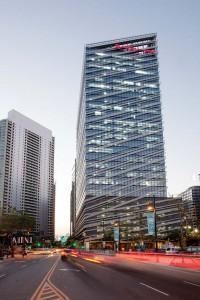
CERTIFIED ‘GREEN’ – Net Lima of The Net Group, a boutique office building located at Bonifacio Global City, is a 4-Star Building for Ecologically Responsive Design Excellence (BERDE) Project under the BERDE for New Construction version 1.0.0. It is the first certified green building under the BERDE Green Building Rating System, certified by TÜV Rheinland Philippines, Inc., a duly-accredited certification body of the Philippine Green Building Council (PHILGBC). (Photo courtesy of The Net Group)
( Article first Published on: Manila Bulletin.com | November 25, 2014)
For the past 30 years, Filipinos have been renewing their interest in constructing green buildings as they face more complex environmental problems. Taking advantage of the world’s most abundant and free energy sources are a priority factor in pursuing this cause. We can collaborate... visit our site www.eco.ph today!
“Green buildings are new kinds of buildings that are environment-friendly. These are [structures] that consume less electricity and water, and produce less waste,” Philippine Green Building Council (PHILGBC) Chairman Christopher dela Cruz told the Manila Bulletin.
Nowadays, green buildings utilize solar panels and consist of high-performance glass, which reduces the amount of heat entering the buildings, lessening the need for air-conditioners, he said.
Other features he cited include eco-friendly air-conditioners, structures that can recycle used water, small-scale wind turbines, and green roofing.
“We also look into heritage conservation, as a priority factor in constructing green buildings,” Dela Cruz said.
Green buildings are now constructed using the modular method, which involves assembling large structural parts in modules or groups. Construction also generates less waste.
Planning for green buildings involve full coordination among architects, engineers, contractors, and others, who must design structures with reducing pollution in mind.
“Green builders” collaborate with not just the Department of Environment and Natural Resources, but also other government agencies, to meet compliance standards.
“The construction of green buildings have created ‘green jobs,’ as new standards, products, and services arise,” dela Cruz said.
In the country, many of these green buildings can be seen in Makati, Quezon City, Manila, Mandaluyong City, Taguig, as well as in Cebu City and Davao City.
“As the Philippines currently has the highest electricity rates in Asia, businesses in the country treat electricity bills as among their major expenses,” Dela Cruz said. “This affects the competitiveness of our companies.”
PHILGBC uses its own accreditation system called Building for Ecologically Responsive Design Excellence (BERDE) to enact voluntary standards, and certify buildings in the country.
The Department of Public Works and Highways (DPWH) is currently drafting the Green Building Code, which will follow the National Building Code and its implementing rules and regulations.
The proposed code will tackle energy efficiency, water and wastewater management, solid waste management, materials and site sustainability, and indoor environmental quality.
If properly enforced, the said code will generate up to R35.2 billion in savings by 2030.
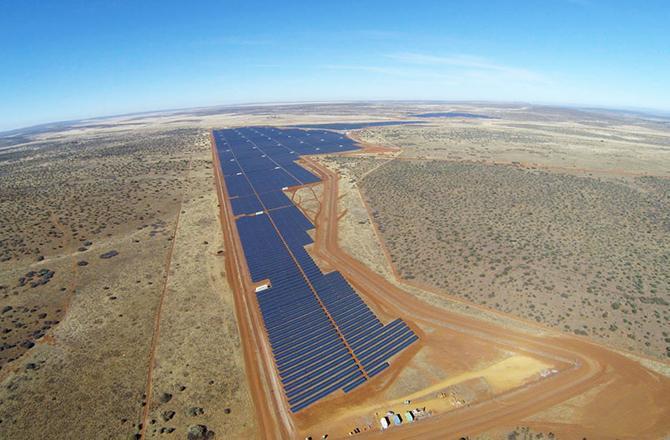
Size doesn’t matter……but why not cut out the middle man and tap directly into the most abundantly available energy source for free utilizing SG Eco’s ground breaking ventilation and lighting technologies…..visit us at www.eco.ph today!
Compared with other places around the globe, South Africa ranks among the sunniest. It gets some the highest average number of hours of sunshine per day: 8.5 hours compared with 3.8 in London, 6.4 in Rome and 6.9 in New York. So it makes sense that someone would want to build a giant solar farm there.
Crazy Solar Power Plants
Renewable energy company SolarReserve, headquartered in Santa Monica, Calif., is one such place. This month they announced they had the Jasper solar farm, located near Kimberley in South Africa, running at full capacity. The 96 MW installation is Africa’s largest solar power project.
About 325,000 photovoltaic modules will deliver 180,000 megawatt-hours of renewable electricity annually to region. That’s enough to power 80,000 homes.
Like other countries around the world, South Africa is trying to reduce carbon emissions as well as increase renewable energy sources. They’ve set a goal of having 18 gigawatts of clean energy online by 2030. The Jasper project is one such installation getting the country closer to its goal.
Solar-Powered Bulbs Brighten Off-Grid Homes
The Jasper project is one of a few big solar power plants coming online in Africa. In 2015, the 155-megawatt Nzema project in Ghana will provide that country with electricity. And Morocco aims to build several solar energy plants that will generate 2,000 megawatts of electricity by the year 2020.
Let it shine.
via Treehugger
Credit: Solar Reserve
(Source: news.discovery.com)
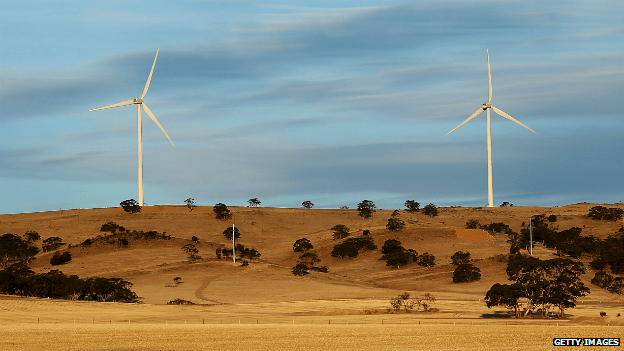
The key point isn’t the politics, policies or subsidies……it’s about incentive and if your objective is to save money by tapping into the world’s most abundant and free energy source by accessing technologies available right now then, check out our site at www.eco.ph and get in touch. We’d love to help you save money starting right now!
The Climate Council says foreign investors are going to other countries because Australia's government has no clear renewable energy policy.
Australia has gone from "leader to laggard" in energy projects, it added.
Another new report says Australia will need to raise its carbon emission reduction target to 40% by 2025.
The damning report on the state of renewable energy, entitled Lagging Behind: Australia and the Global Response to Climate Change, said the country was losing out on valuable business.
Investment that could be coming to Australia was going overseas "to countries that are moving to a renewables energy future", said Tim Flannery, one of the report's authors.
He said most countries around the world had accelerated action on climate change in the last five years because the consequences had become more and more clear.
The report found China had retired 77 gigawatts of coal power stations between 2006 and 2010 and aimed to retire a further 20GW by next year.
It also said the US was "rapidly exploiting the global shift to renewable energy" by introducing a range of incentives and initiatives to investors.
The future of Australia's renewable energy industry remains highly uncertain, the report concluded, because of a lack of clear federal government renewable energy policy.
"Consequently investment in renewable energy in 2014 has dropped by 70% compared with the previous year," it said.
'A high risk approach'
The second new report, by the Climate Institute, calls on Australia's government to announce an "independent, transparent" process for setting the post 2020 carbon emission reduction targets.
Erwin Jackson, deputy chief executive of the climate body, said too much of the political debate had "ignored growing scientific, investment and international realities".
"This short-term focus is simply a high risk approach to the significant challenges of decarbonising our economy and helping avoid dangerous impacts for Australia," he said.
Prime Minister Tony Abbott is under pressure to cut the country's emissions much further than the government has planned after the European Union moved to set a new target of 40% by 2030.
The EU said the agreement, which includes a 27% target for renewable energy by 2030, should set a new global standard.
Mr Abbott's government has said it will discuss a post-2020 target early next year and it is likely to come under more pressure this weekend at the G20 summit, which is being held in Brisbane.
Source: bbc.com

An absence of natural light in some police custody suites causes personnel and detainees "emotional suffering" as well as headaches and eye strain, it has been claimed.
The fact that many custody suites are devoid of windows has been linked to burnout and psychological anxiety among staff, and this is exacerbated by harsh strip lighting, said Andy Ward from the UK’s Police Federation.
Mr. Ward, the Federation's joint lead on custody, cited research by occupational health expert Dr. Jonathan Houdmont which showed a link between a lack of access to natural light and exhaustion.
"I did six years solid in custody suites where there was absolutely no natural light," Mr. Ward said following a conference in London at which he raised the issue. "You don't necessarily think about it at the time, but when there are dark mornings and dark nights, sometimes you don't know whether it is day or night."
Attempts to "design in" natural light in custody environments have been stymied by the imperative to maintain security and privacy.
Installing windows could mean detainees being able to see co-defendants being brought into custody - which could wreck cases - and possibly increase the chance of people escaping from their cells.
Some custody suites are located in basements underneath police stations in order to keep detainees isolated.
Dr. Houdmont told PoliceOracle.com his research had found "a positive correlation between reports of a problematic lack of natural light and burnout or emotional exhaustion."
He added: "The less natural light people have at work, the more knackered they are, to put it bluntly."
There was evidence this also impacted on custody staff members' commitment and intention to remain in post, he said.
Depression and anxiety have also been linked to a lack of natural light - as have headaches and strained eyes.
Dr. Houdmont suggested using translucent glass or Perspex, rather than transparent glass so that detainees could not see co-defendants being brought in.
In some newbuild custody suites glass roofs have been installed to try and address the problem.
Marcus de Guingand, Managing Director of occupational health company Third Pillar of Health, said: "In offices and homes most lights are what we would term yellow lights, whereas light from the sun, which gives us melatonin [the 'circadian rhythm hormone'] is more on the blue or green part of the spectrum."
This study suggests that natural light is not only desirable in homes and workplaces but even in police custody suites. Lack of access to natural light can be linked to exhaustion and health issues amongst working personnel and detainees.
SG Eco is a leading provider of sky lights which use natural light to provide interior lighting. For more details about our products, contact us at +63 (45) 499 1037 or visit our site at www.eco.ph
Source: http://bit.ly/1E4aeCH







